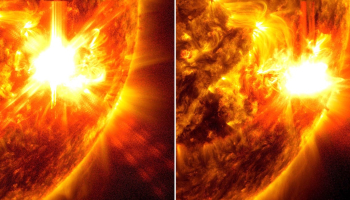
[ad_1]
Are we closer to the “Holy Grail” of clean energy? Silicon Valley wants you to believe.
This week, nuclear fusion startup Helion announced that it had inked a first-of-its-kind deal with Microsoft to provide 50 megawatts of power from a yet-to-be built power plant, all within the next five years. Unlike nuclear fission, the process that powers all the nuclear power plants existing today, nuclear fusion could create potentially unlimited energy. It’s a dream that scientists and engineers have been chasing for decades, with little luck.
The announcement from Helion and Microsoft is historic—and raises a lot of thorny questions about fusion, the role of tech in promoting new energy sources, and whether all this talk about fusion is even doing any good for the planet.
What is nuclear fusion, and why has it been so difficult to achieve?
Nuclear fusion is, simply put, the same process that powers the Sun. The Sun turns matter into energy through the enormous pressures and high temperatures at its core.
“If you smash atoms together hard enough and in a hot enough and dense enough environment, you can get essentially free energy,” said Charles Seife, a journalism professor at NYU’s Arthur L. Carter Journalism Institute and the author of Sun in a Bottle: The Strange History of Fusion and the Science of Wishful Thinking. “It’s enormous amounts of energy from very little fuel,” he told Earther.
Physicists have been chasing the dream of replicating the fusion process since the 1940s, when research into building nuclear reactors began. It quickly became clear that the problem was not replicating fusion itself but rather creating conditions in which the process produces more energy than it takes in. Fusion needs an enormous amount of energy, and almost all of the demonstrations of fusion scientists have accomplished thus far have not been able to reach the point where the energy output is greater than the input.
Recently, there have been a spate of announcements that seem to signal a potential turning point for fusion research. Perhaps most importantly of all, the Lawrence Livermore National Laboratory in December announced that it had gotten energy net gain in a fusion reaction—a process known as ignition.
Seife said that the Livermore announcement is significant but pointed out that manufacturing the lasers used at Livermore and creating other inputs to set up the fusion process require much more energy than is accounted for in the final equation. He’s less impressed by the numerous nuclear fusion startups that have cropped up in Silicon Valley and elsewhere in recent years.
“I think there’s been something of a hype cycle” around fusion recently, he said. “There’s been a lot of venture capital flowing, and people have gotten better and better at leveraging dumb money into hype. You’ve got a lot of startups blooming everywhere that are replicating stuff that we were able to do in the 1960s in small labs, and putting their own spin on it. Because there’s so much money in the system, and so much desire to have this technological solution, people are very excited—and totally ignoring the fact that there is no result that has any energy output to it.”
What is Helion, and what is it promising?
Speaking of startups: enter Helion. Helion was founded in 2013 and was helped along by an infusion of cash from startup accelerator Y Combinator in 2014. That year, its CEO claimed that Helion could get a fusion reactor up and running in three years; two years ago, he said that the company would be able to generate fusion power and “go after commercially installed power generation” by 2024.
Despite the repeated misses on the timeline, Helion broke ground on its first reactor site in 2021, thanks in part to a $375 million investment from Silicon Valley entrepreneur Sam Altman. It has now become the first fusion company to ink an actual power purchasing agreement for its services, and says that it will start supplying power to Microsoft in 2028—more than 10 years after it initially said its reactor would be built.
Earther reached out to Helion to ask about its confidence in the timeline given its past misses. The recent results of its sixth prototype of a fusion reactor, a spokesperson wrote in an email, “give us great confidence that our timeline is realistic and that we can build the first fusion power plant by 2028.”
Can they actually do it?
Despite the company’s cheery outlook, there’s a lot of skepticism from experts around the Helion and Microsoft announcement, particularly the truncated timeline—including from Seife, who nevertheless says that he understands the hype.
“It’s so beautiful on paper,” Seife said. “That’s the appeal of it.”
Beyond Helion’s ability to perfect a process in five years that decades of research hasn’t yet gotten us to, there’s also a marked difference between advancing the science of fusion itself—which would alone be an incredible feat—and harnessing fusion for energy. A lot of the funding behind nuclear fusion in recent years in the U.S. has focused on achieving ignition, without an additional focus on creating usable energy from fusion; it’s a whole separate ballgame to actually put energy on the grid with the process. (Building a power plant alone is already a big infrastructure project that can take a couple years at best.)
“The classic joke is, okay, if you can produce energy, make me a cup of tea,” Seife said. “Once you make me a cup of tea, I will consider paying you money to do something, but first, make me a goddamn cup of tea.”
Is banking on fusion good for the planet?
A spokesperson for Helion told Earther in an email that the details of its power purchasing agreement with Microsoft won’t be made public. “That said, this is a real PPA, with commitments and obligations as well as penalties for failing to meet them,” the spokesperson said.
There are many questions left unanswered—has Microsoft paid Helion any money up-front? What are those commitments, obligations, and penalties, specifically? And, perhaps most importantly from a climate perspective, how much is Microsoft banking on this carbon-free fusion power?
In a press release from Helion, the company said the agreement would “help Microsoft to achieve its goal of being carbon negative by 2030.” When asked if the company has other ways of sourcing the clean power needed to meet the “carbon negative” benchmark if the Helion plant does not come online, a Microsoft spokesperson pointed us to the company’s 2022 Sustainability report.
Even if Microsoft has back-up plans built in, there’s something to be said for a large company agreeing to let a startup with dubious timelines use its reputation to launder its image. The world is on the brink of an enormous energy revolution, and there’s no question that an energy source like nuclear fission, which provides valuable carbon-free baseload energy to the grid, has a crucial role to play; fusion energy could be even more beneficial to the energy transition. That said, we don’t have much time to make the big changes we need. Creating plans that rely on technologies that haven’t been fully tested—and listening to Silicon Valley technocrats who keep making big promises and aren’t held to account when they don’t deliver—wastes valuable time, energy, and money that we could be spending on the clean energy technologies that we have today or are much nearer to deployment.
“The difficulty of getting this working—from a climate point of view, I’m afraid it’s doing active damage,” Seife said. “The accounting we have to do, the hard choices we have to make, are deferred because we have a genie that’s going to come out of this lamp in five years.”
[ad_2]
Source link






